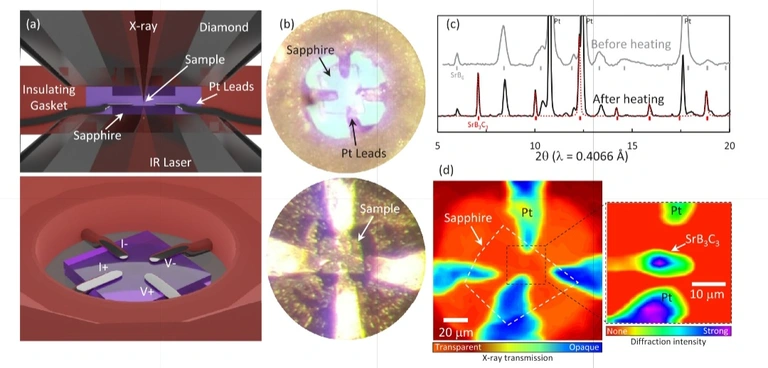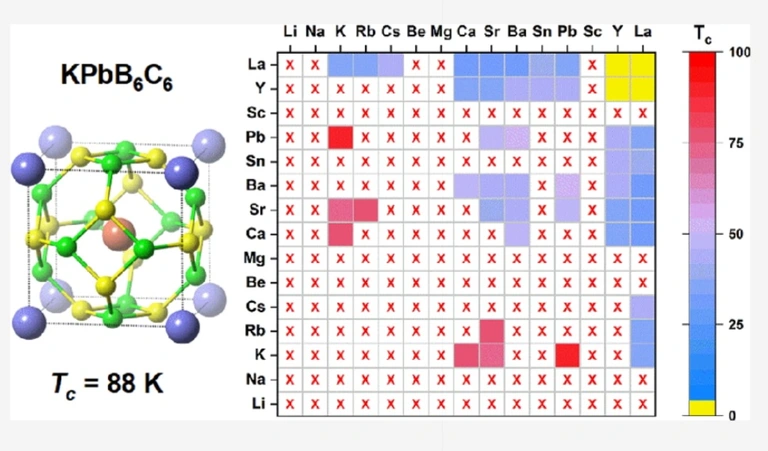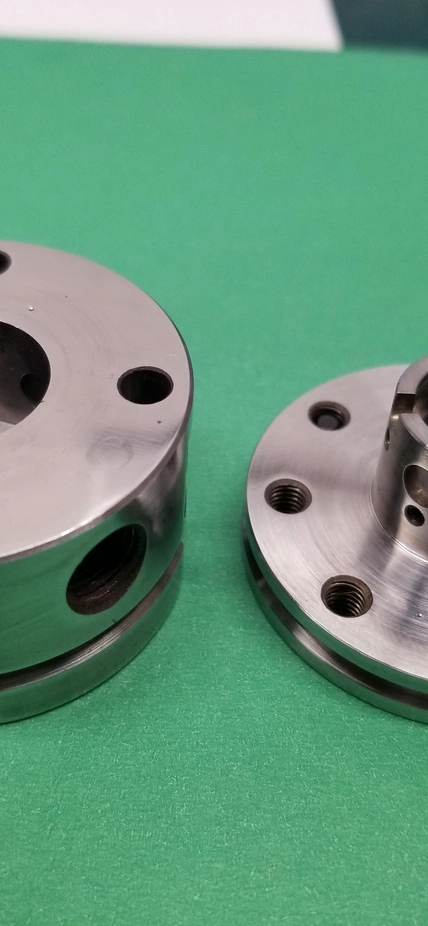Washington, DC—A team of researchers led by Carnegie’s Timothy Strobel and Li Zhu recently showed evidence for superconductivity in a “superdiamond” material comprised of carbon and boron lattice arranged in a cage-like structure entrapping strontium atoms. Their findings, published last month in Physical Review Research, are part of a larger push to use carbon-boron clathrate materials to advance high-temperature superconductivity.
This diamond-like, metallic carbon-boron clathrate, SrB3C3, was first predicted and synthesized by Strobel and Zhu in 2020. At that time, they noted a potential for conventional superconductivity due to the light-weight elements and the electronic properties induced by the caged strontium atoms.

“We have continued to probe the possible applications of this material over the last several years,” Strobel said. “Our calculations predicted superconductivity would appear under the right conditions, and our experimental results suggest that it emerges at about 22 Kelvin under high-pressure conditions and is predicted to increase further to approximately 30 Kelvin at atmospheric pressure. These temperatures are considered moderately high when it comes to superconducting transitions.”
Superconductivity is a property in which electricity can flow freely with no resistance. It can be brought about in certain materials when they are cooled below a critical temperature, which is different for each compound.
The extreme cold required for most superconductors is not very efficient or cost effective for everyday applications, so scientists are always seeking materials that can exhibit these properties under temperature conditions that can be achieved by more simple means, such as cooling with liquid nitrogen. Materials with light elements such as hydrogen, boron, and carbon are predicted to be promising candidates to increase superconducting transition temperatures.
“If superconductivity could reliably be achieved under conditions that aren’t so expensive to create, it could spur major advances in computing, transportation, communications, and medical technology,” Strobel added.
The structure of clathrates enables their properties to be adjusted depending on the type of atom trapped inside their cages. As a result, Strobel and Zhu say that some other carbon clathrates will exhibit superconductivity at even higher temperatures than their superdiamond SrB3C3.
In another paper, published in the Journal of the American Chemical Society with colleagues at State University of New York Buffalo, the team predict 18 new superconducting clathrate structures involving carbon-boron lattice cages with one or two metals trapped inside them.

“Our calculations show that the size and charge of the metal atoms inside the clathrate affects the structural stability and the temperature at which superconductivity emerges,” Strobel explained. “It appears possible to obtain superconducting transition temperatures approaching 100 K with these types of materials.”
Looking ahead, he and Zhu hope to synthesize some of these additional superconducting carbon clathrates in the lab to probe the limits of their properties.
Their co-authors on the Physical Review Research paper include Carnegie’s Hanyu Liu, Piotr Guńka, Thomas Shiell, and Ronald Cohen, as well as Maddury Somayazulu, Yue Meng, and Curtis Kenney-Benson of Argonne National Laboratory; Stella Chariton and Vitali Prakapenka of the University of Chicago; Hyeok Yoon, Jarryd Horn, and Johnpierre Paglione of University of Maryland; and Roald Hoffmann of Cornell University.
The Journal of the American Chemical Society paper was published with co-authors Nisha Geng, Katerina P. Hilleke, Xiaoyu Wang, and Eva Zurek of SUNY Buffalo.
Acknowledgements
The PRR work was supported by the U.S. Department of Energy (DOE) Office of Science, Basic Energy Sciences. Experiments at the University of Maryland were supported by the Gordon and Betty Moore Foundation’s EPiQS Initiative. Computations were carried out at the Memex cluster of Carnegie Institution for Science. Portions of this work were performed at HPCAT (Sector 16), and GSECARS (Sector 13), Advanced Photon Source (APS), Argonne National Laboratory. HPCAT operations are supported by DOE-NNSA’s Office of Experimental Sciences. GeoSoilEnviroCARS is supported by the National Science Foundation – Earth Sciences and Department of Energy- GeoSciences. The Advanced Photon Source is a U.S. DOE Office of Science User Facility operated for the DOE Office of Science by Argonne National Laboratory.
The JACS work was supported by the U.S. National Science Foundation, the U.S. Department of Energy, National Nuclear Security Administration through the Capital-DOE Alliance. Calculations were performed at the Center for Computational Research at SUNY Buffalo. Work at Carnegie was supported by the U.S. Department of Energy, Office of Science, Basic Energy Sciences.
